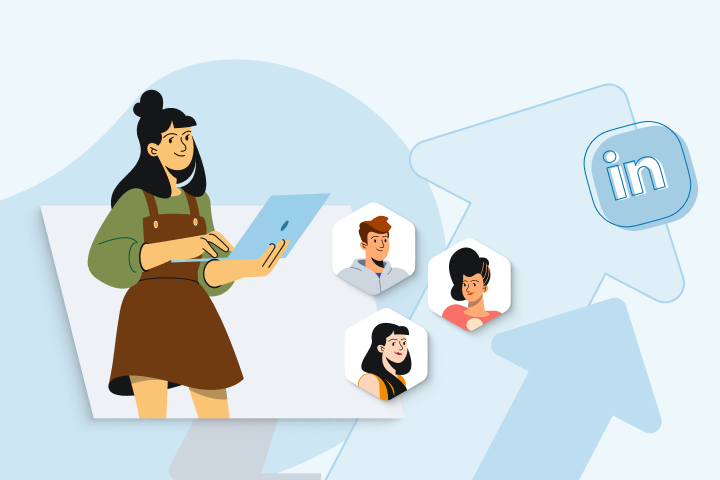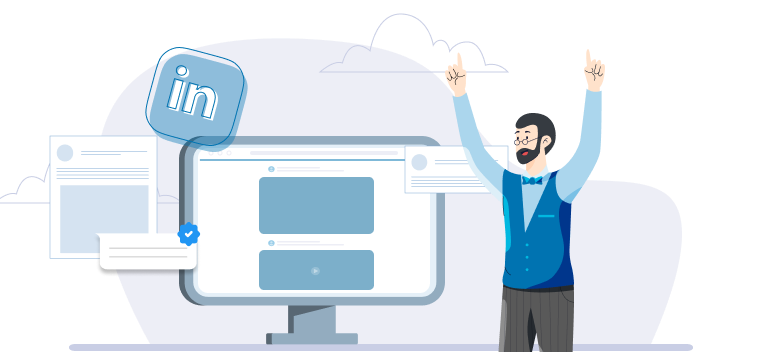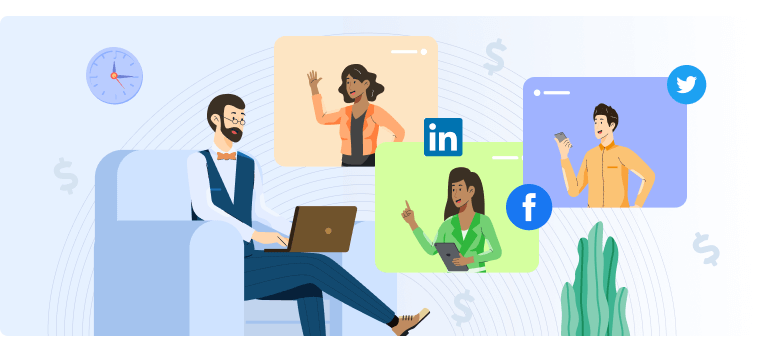Social Selling B2B: Strategies to Build Trust and Drive Revenue
Most B2B social selling strategies look like this:
-
Sales reps optimize their LinkedIn profiles.
-
Sales reps use Sales Navigator to find prospects that fit their ideal customer profile.
-
Sales reps send a cold outreach or connection request to those people with a pitch of their product or service.
While this process can help you generate some leads, you'll likely find that most people don't respond to your sales reps’ cold outreach.
Unfortunately, LinkedIn limits the number of cold outreaches you can send (and might even ban you if you send too many unaccepted connection requests), so this process isn't very scalable.
However, a handful of the top-performing social sellers have outstanding (50%, 60%, and 70% plus) response rates.
The key to their success is implementing a social selling strategy that attracts the ideal customer rather than chasing them.
In this post, we'll lay out a step-by-step strategy to help your team become top-performing social sellers.
What Is Social Selling for B2B Businesses?
B2B social selling is a lead generation method that sales professionals use to connect with prospects on social media (usually LinkedIn) and increase deal flow.
The main benefit of social selling is that a well-executed strategy can drive millions of dollars in pipeline revenue. To help your sales team become top-performing social sellers, here's a proven B2B social selling strategy.
B2B Social Selling Strategy
Below we'll lay out a step-by-step B2B social selling strategy that the top-performing social sellers use to build authentic (and profitable!) relationships with ideal customers.
Step 1: Optimize Your LinkedIn Profile
Optimizing your profile is the first LinkedIn social selling best practice since it’s a prospect's first impression of you. To optimize your profile:
-
Use a high-quality profile picture.
-
Upload a relevant cover photo.
-
Fill out your bio and create a compelling About description.
-
Add relevant certifications, licenses, and work experience.
-
Ask colleagues for endorsements.
Once you've covered the basics, the next step is to look at your LinkedIn Social Selling Index (SSI). This is a score that LinkedIn provides users, and it's based on these four components:
-
Establishing your professional brand (your profile).
-
Finding the right people (sending connection requests to relevant people).
-
Engaging with insights (creating relevant content).
-
Building relationships (interacting with decision-makers).
You can find your current SSI score by following the link to LinkedIn's Social Selling Index page and clicking "Get your score."
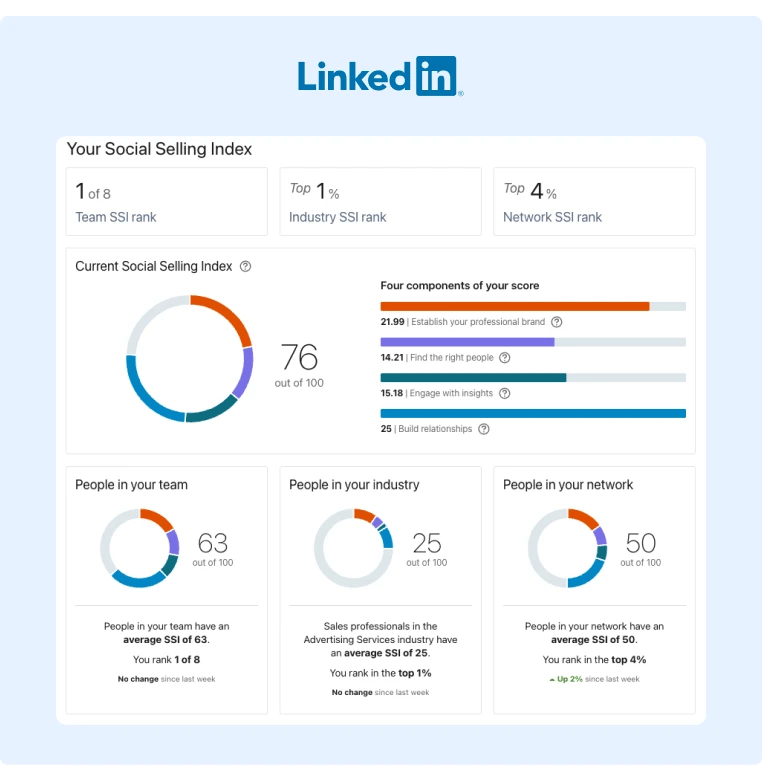
While the SSI doesn't impact your content's performance on LinkedIn, it is a helpful guide as you get started with social selling. You can also watch that score grow as you implement the strategy we lay out below.
Step 2: Create a Content Strategy
While most social selling advice revolves around optimizing cold outreach messages, we recommend creating valuable content that attracts the right buyers to you.
Content marketing requires much more work for a smaller ROI in the short term, though we've found it ultimately has a much higher ROI than cold outreach in the long run.
In addition, content builds trust and goodwill with your audience and shortens the sales process when the audience is ready to buy because:
-
The prospect is already familiar with your products/services.
-
You also don't have to spend time building rapport.
-
The prospect is probably a good match because your content clearly resonated with them.
What does a winning LinkedIn content strategy look like?
It's simple:
-
Create high-quality posts.
-
Publish several times per week.
-
Be consistent for several months/years.
However, just because it's simple doesn't mean it's easy.
Let's break down the three components of a winning LinkedIn content strategy.
1. Create High-Quality Posts
The most successful LinkedIn posts typically incorporate personal stories and/or experiences. This could be a case study, a proven framework, or a hard lesson learned.
Instead of just writing generic advice, share hacks you use daily, lessons learned from case studies, and insights from conversations with other experts.
Once you've created the content, be sure to follow basic optimization tips like:
-
Adding relevant hashtags.
-
Tagging relevant influencers and co-workers.
-
Crafting a captivating hook.
-
Posting at an opportune time (e.g., avoid Friday nights and weekends).
It takes years to become a great writer, so start practicing today. Over time, you'll discover the topics and styles that resonate best with your audience.
2. Publish Several Times Per Week
Social media algorithms are designed to show users the most recent content. Unlike blog content, most social media content is only relevant for a day or two.
This means that publishing a high volume of quality content can significantly increase your LinkedIn growth.
If you're struggling to publish content frequently, consider repurposing longer-form content into several LinkedIn posts and even reposting your past top-performing content.
3. Be Consistent for Several Months/Years
The biggest drawback of organic social media marketing is that it takes a long time to produce results.
It can be difficult to stay motivated and consistently create quality content.
To solve this problem, block out time once per week for LinkedIn content creation and then schedule all of your content in advance with a tool like Buffer.
Step 3: Promote Your Content
Content marketing takes a long time to produce results, though there are a few things you can do to gain traction faster.
Here are a few of our go-to content promotion strategies:
Employee Advocacy
Social algorithms typically give content with high organic engagement additional organic reach as it clearly resonates with users. To help your posts gain initial traction and achieve more organic reach, ask your colleagues to engage with the content.
Here's an excellent example of employee advocacy in action. You can see that the CEO created a post discussing brand initiatives, and then some of the other employees engaged with it organically:
If you're looking for a tool that automates the employee advocacy process for you, consider GaggleAMP.
Instead of sending out mass emails or Slack messages begging your employees to engage on LinkedIn, GaggleAMP allows sales leaders to send personalized engagement requests to employees at scale.
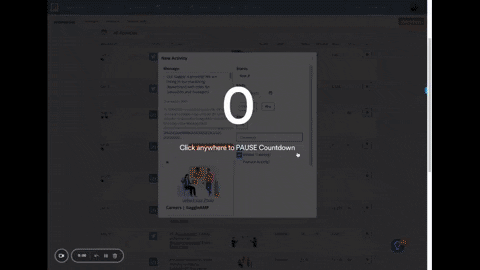
After assigning the engagement activity, employees receive a notification that they have a new activity. They can then log into their personal Gaggle dashboard to see a list of engagement activities and any specific instructions you added to the activity.
Providing specific instructions like which post to engage with and how to engage (like, comment, share, etc.) reduces the effort required on your employees' part, which ultimately increases engagement rates.
Brand Partnerships
Ask your existing customers what other products/services they use in combination with your product/service. Then, reach out to those brands and pitch a collaboration, like a joint webinar, podcast, or case study.
Here's a great example of a brand partnership in action between two leaders with similar audiences (a webinar platform and a landing page platform):
In this case, many webinar users also use a landing page builder, so it made sense for these two brands to collaborate as they have the same target audience.
Influencer Partnerships
Influencer partnerships are similar to brand partnerships, though the difference is that influencers tend to be individual experts rather than a spokesperson from a brand.
While paying influencers to promote products is relatively common in e-commerce, it's less common in B2B. Fortunately, you can usually get B2B influencers to share your content if you mention and credit their ideas in your post. Many will organically share that content with their audience because it makes them look good.
Here's a great example of how an individual took an idea (the alter ego effect) from a B2B influencer (Todd Herman) and credited him. As a result, Todd engaged with the post, which helped it gain traction and reach a larger audience.
Alternatively, you can also ask B2B influencers to do a podcast interview with you and repurpose it as LinkedIn content.
Step 4: Engage With Others
The easiest way to build relationships and engage with others is to respond to people who comment on your posts. This is one of the most overlooked opportunities to build genuine relationships.
Even if you just write "thank you" or "you're welcome," it builds goodwill and encourages people to continue engaging with your content.
Neil Patel does a great job of responding to comments.

Commenting on your ideal prospects' posts is an even more effective way to build goodwill as it's both flattering that you found their content insightful enough to engage with it and because engagement helps them rise in the algorithm.
Consider blocking out time each week to engage with your prospects' content.
Finally, you can also join LinkedIn groups and help those asking for advice (though avoid offering unsolicited advice).
The key is to find highly engaged groups. Many LinkedIn groups are overrun with B2B marketers promoting their content, and few people engage authentically. Look for a few high-quality groups and only offer value where it's appropriate.
Step 5: Connect With Key Decision Makers
Now that you have a content flywheel going, your direct outreach will likely have a much better conversion rate for a couple of reasons:
-
Prospects can read your thought leadership content to see that you're an expert. If you wrote about any case studies, they'll also see that you can produce results.
-
Prospects can see that other people also engage with your content, which gives you more social proof and credibility.
The next step in the social selling process is to connect with key decision-makers.
You can do this in LinkedIn Sales Navigator by searching for your ideal customer profile (title, company size, location, etc.).
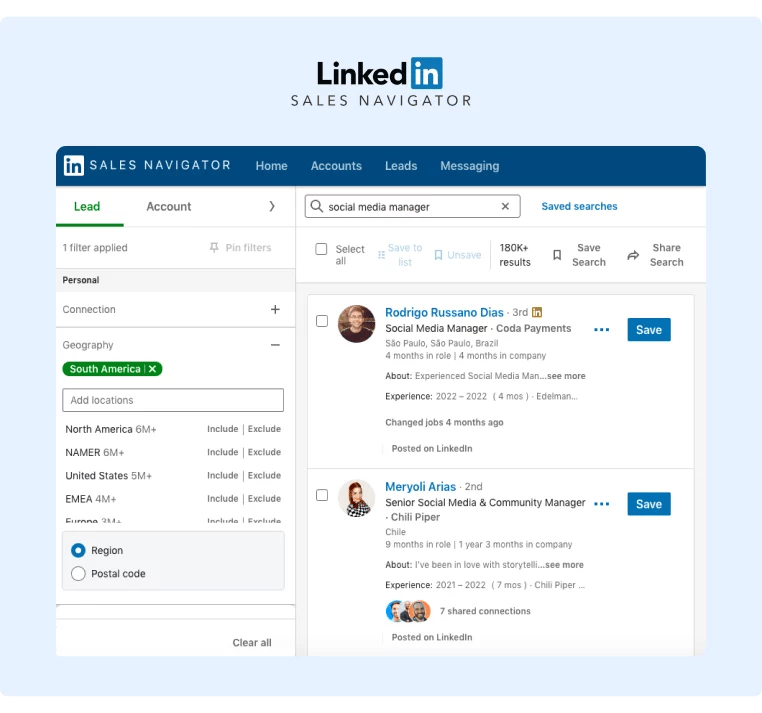
When you find interesting people, save them to a lead list and send a personalized connection request.
To increase your connection acceptance rate, provide value to them first.
A great way to do that is to comment on one of their recent posts and then mention that post in your connection request.
Here's a template you can use:
"I read your post about improving blog post conversions. I definitely agree with (the post's point). Looking forward to more content!"
This template works well because it shows you've consumed their content and offers subtle flattery (looking forward to more content!).
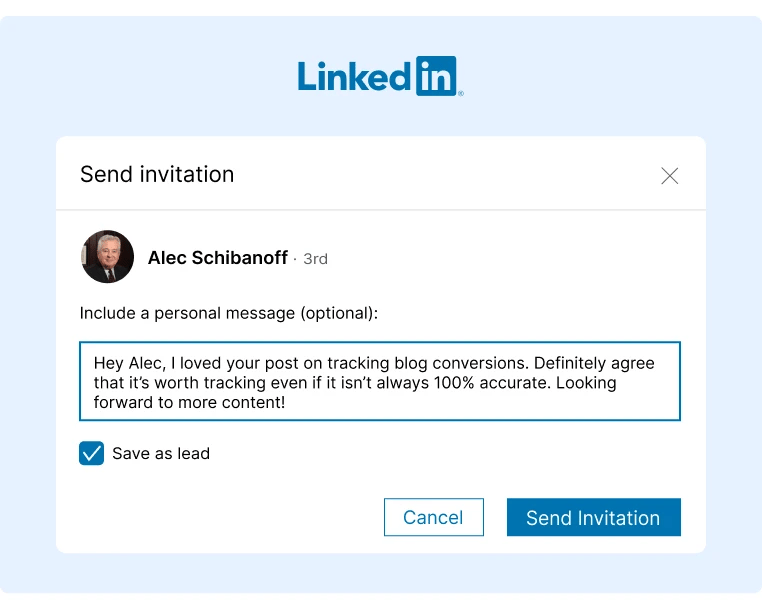
Increasing your connection request acceptance rate is important because LinkedIn may ban you if you send too many unaccepted connection requests.
Once prospects accept your connection request, comment on their content weekly. After a few weeks, send a message with a value-first pitch of your product.
What does a value-first pitch look like?
It focuses on how your product/service will help them achieve their goals. Ideally, provide something of value, like a personalized site audit.
Over time, your content strategy will take off, and you won't need to send any messages because you'll have so much inbound interest.
B2B Social Selling Examples
To give you some inspiration, here are four examples of outstanding B2B social sellers.
Some commons themes you’ll notice are:
-
They provide a case study/proven process that the person used to achieve their goals.
-
The person publishes this kind of content consistently (several times per week).
-
The person responds to comments and engages authentically.
1. Justin Rowe
Justin Rowe runs a LinkedIn ad agency, so it's no surprise he's excellent at selling on social media. He has said in multiple posts that his organic content has driven new leads and real customers.
Here's just one of those posts:
Notice that he isn't selling anything in the post, but it led to several people asking about his services (myself included).
2. Brendan Hufford
Brendan Hufford runs a marketing agency and has built his personal brand on LinkedIn by regularly sharing authentic content. It's usually a framework he uses internally, a case study, or a lesson learned.
In this rare post where he does sell his services, it received over 70 comments (many of which were from highly interested decision-makers at reputable B2B brands).
While this post does directly sell his services, I encourage you to scan his profile as you’ll see that most of his posts are insightful and helpful and often draw from his own personal experiences.
3. Rand Fishkin
The two examples above show how you can leverage social selling through a personal brand to sell services.
Does social selling work if you're selling a product?
Rand Fishkin is an excellent proof that social selling does work for products!
His trick to crafting successful social selling posts is opening with a customer pain point rather than a product pitch.
I read each of his product pitches because his insights around each pain point are so interesting. He then transitions smoothly into a product pitch by showing how his product solves that specific pain point. Even if you don't purchase his product, you'll still learn something new and interesting by reading his posts.
Here's an example of one of his social selling posts:
It's also worth noting that only a handful of his posts are product pitches. Most posts are thought-leadership or educational style content.
4. Devin Reed
Devin Reed, the Head of Content at Clari, is another excellent example of a great B2B social seller.
He consistently posts valuable content for sales leaders (his company's ideal customers) and frequently promotes lead magnets and webinars.
Here's just one example of a post he created that offers value (a framework for writing cold emails) and promotes an upcoming webinar.
As you can see, this post doesn't just beg people to attend his webinar. It has a captivating hook, provides interesting insight into a common challenge, and then offers the webinar as a resource to learn more.
Devin also publishes quality thought leadership content about four to five times weekly. Content over time gets pushed down in the feed, and a time sensitive post is only relevant for up to 24 hours. So, it's important to consistently publish content to grow an audience.
Implement a B2B Social Selling Strategy Today
Social selling is about creating content that attracts your target audience and building authentic relationships.
If you want to help your entire sales team to become master social sellers, consider using a tool like GaggleAMP that allows you to assign specific engagement activities to specific team members.
This will help you guide your team through the social selling process and ultimately help the brand reach its sales goals.
To see for yourself how GaggleAMP can help, schedule a demo today!




